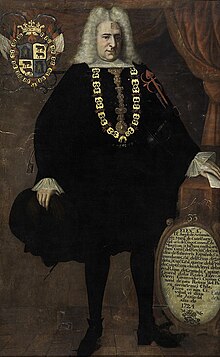José de Armendáriz
José der Armendáriz , (also: Armendaris ) Margrave ( marqués ) of Castelfuerte, Burgrave ( vizconde ) of Villacerrada (* 1670 in Ribaforada , Navarra region , Spain (according to other sources: Pamplona , Spain); † April 16, 1740 in Madrid , Spain) was a Spanish officer and colonial administrator who served as Viceroy of Peru from 1724 to 1736 .
Life
Origin and youth
Armendáriz came from a family of the Spanish nobility from Navarre, his parents were Juan de Armendáriz e Irrisarri and Juana García de Garrués. José de Armendáriz embarked on a military career at an early age. In the Palatinate War of Succession he fought for the Spaniards in Flanders : in 1690 in the Battle of Fleurus and in 1693 in the Battle of Neer winds .
Military career in Europe
In the War of the Spanish Succession he fought on the side of the later victorious Bourbon Philip of Anjou . Armendáriz fought in Catalonia and Italy in 1702, in 1704 he took part in the capture of Gibraltar and also fought in the siege of Barcelona in 1713. He rose in the military hierarchy from brigadier to general colonel and general.
After the end of the war he served as governor of Tarragona and Guipúzcoa as well as inspector general of the cavalry and the dragoons of the Crown of Aragon.
Tenure as viceroy
In October 1723, King Philip V appointed him Viceroy of Peru. He immediately embarked for South America and reached Cartagena in February 1724. In May 1724 he made his ceremonial entry into Lima and took over the official duties of his predecessor Diego Morcillo Rubio de Auñón , Archbishop of Lima.
Like his predecessors, Armendáriz had to deal with stabilizing state revenues. He tightened the requirements for the forced labor of the indigenous population ( Mita ) in order to increase the yield from the silver mines of Potosí and Huancavelica . Several employees of the mint were jailed under his rule for corruption and counterfeiting.
He punished the illegal trade that flourished in the ports of Arica and Iquique with French and Dutch merchant ships with the death penalty. In addition, he had the port fortifications of Callao reinforced.
The uprising in Paraguay , which had already preoccupied its predecessor, dragged on under Armendáriz 'rule . The Jesuit order had set up a system of missionary institutions that protected the indigenous population from forced labor. The Jesuit-friendly governor Diego de los Reyes Balmaceda had been ousted by the local jurisdiction in a questionable process. In his place, the judge José de Antequera had taken power. There was a real uprising, the Jesuits were expelled and royal Spanish troops from Buenos Aires were repulsed. Armendáriz ordered the governor Bruno Mauricio de Zabala in Buenos Aires to finally put down the uprising. Antequera fled to the highlands and Lima, was arrested in 1726 and put on trial in Lima. In 1731 he was beheaded.
As a result, further uprisings occurred among the indigenous population.
Regardless of his tough line towards insurgents and locals, Armendáriz had a difficult position against church jurisdiction. In 1732 he had to defend himself before the Inquisition on charges of blasphemy.
Even his rule was not spared from natural disasters: In 1730 a severe earthquake struck Chile , which caused severe damage in Santiago and Concepción .
Return to Europe
In 1736 he handed over the official business to his successor, José Antonio de Mendoza Caamaño y Sotomayor . He returned to Spain, lived in Pamplona and Madrid. For his services he was appointed captain of the royal guard and accepted as a knight in the Order of the Golden Fleece . He died in Madrid in 1740.
literature
- Manuel de Mendiburu (1805-1885): Diccionario histórico-biográfico del Perú . tape 1 . Imprenta J. Francisco Solis, Lima 1874, p. 346–367 ( ( Page no longer available , search in web archives: cervantesvirtual.com ) [accessed on March 10, 2015]).
Web links
- Short biography (Spanish)
- Biography (spanish)
| predecessor | Office | successor |
|---|---|---|
| Diego Morcillo Rubio de Auñón |
Viceroy of Peru 1724–1736 |
José Antonio de Mendoza Caamaño y Sotomayor |
| personal data | |
|---|---|
| SURNAME | Armendáriz, José de |
| ALTERNATIVE NAMES | Marquis of Castelfuerte, Marqués de Castelfuerte, Burgrave of Villacerrada, Vizconde de Villacerrada |
| BRIEF DESCRIPTION | Spanish grandee, viceroy of Peru |
| DATE OF BIRTH | 1670 |
| PLACE OF BIRTH | Ribaforada or Pamplona , Spain |
| DATE OF DEATH | April 16, 1740 |
| Place of death | Madrid , Spain |
